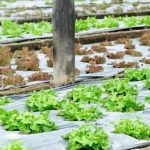Vegetable gardening in Canada is a rewarding and exciting endeavor that allows individuals to connect with nature, produce fresh and healthy food, and create beautiful outdoor spaces. Canada’s diverse climate offers both challenges and opportunities for vegetable gardeners, making it essential to understand the unique conditions of different regions across the country.
From the lush gardens of British Columbia to the colder climates of Ontario, there is a wide range of vegetables that can thrive in Canada’s varied landscapes.
Whether you are a seasoned gardener or just starting out, knowing the best practices for vegetable gardening in Canada is key to success. From selecting the right soil for your plants to planning an effective layout, there are many factors to consider when establishing a garden. Additionally, staying informed about common pests and diseases that may affect your crops will help you maintain a healthy and thriving garden throughout the season.
One of the joys of vegetable gardening in Canada is the sense of community that can be found among fellow gardeners. Sharing resources, knowledge, and experiences with others who share your passion can enrich your gardening experience and provide valuable support when faced with challenges. By embracing sustainable practices and eco-friendly techniques in your vegetable garden, you can minimize your environmental impact while enjoying the beauty and bounty of your harvest.
Climate Considerations
Canada’s vast geography and diverse climate present unique challenges and opportunities for vegetable gardening enthusiasts. From the harsh winters of the northern regions to the temperate coastal climates of the west, Canadian gardeners must navigate a range of conditions to cultivate a successful harvest.
In regions like Ontario and Quebec, where cold winters are common, gardeners must take extra precautions to protect their crops from frost damage. Frost dates vary across the country, with some areas experiencing shorter growing seasons than others. To address these challenges, gardeners can utilize techniques such as raised bed gardening, row covers, and cold frames to extend their growing season and protect plants from unpredictable weather.
On the other hand, British Columbia’s mild coastal climate offers opportunities for year-round vegetable gardening. The temperate conditions in this region allow for a longer growing season and a wider variety of crops to be cultivated. With proper planning and care, gardeners in British Columbia can enjoy an abundance of fresh produce throughout the year.
When it comes to vegetable gardening in Canada, understanding and adapting to the local climate is key to success. By choosing appropriate varieties, implementing season extension methods, and staying vigilant against weather fluctuations, Canadian gardeners can overcome the challenges posed by their unique environment and unlock the full potential of their harvests.
| Region | Climate | Recommendations |
|---|---|---|
| Ontario & Quebec | Cold winters | Raised bed gardening, row covers, cold frames |
| British Columbia | Mild coastal climate | Year-round gardening, wide variety of crops |
Best Vegetables to Grow in Different Regions of Canada
When it comes to vegetable gardening in Canada, the diverse climate and varying growing seasons across different regions can impact what crops thrive best. From Ontario to British Columbia, each province offers a unique environment for cultivating a variety of vegetables. Understanding the best vegetables to grow in these regions can help Canadian gardeners make the most of their gardening efforts.
Ontario
In Ontario, with its humid continental climate, gardeners have a relatively long growing season that allows for a wide range of vegetables to flourish. Popular choices include tomatoes, peppers, zucchinis, cucumbers, and leafy greens like spinach and kale. Root vegetables such as carrots and beets also do well in Ontario’s fertile soil. Gardening enthusiasts in this region can take advantage of the warmer temperatures to experiment with heirloom varieties and unique cultivars.
British Columbia
On the other side of the country, British Columbia boasts a more temperate coastal climate that is ideal for growing certain crops year-round. In cities like Vancouver and Victoria, where mild winters are common, gardeners can enjoy an extended growing season compared to other parts of Canada. Vegetables like tomatoes, cucumbers, lettuce, and herbs thrive in BC’s temperate conditions. Root vegetables such as potatoes and carrots also do well in the rich soil found in this region.
Adapting Across Regions
While certain vegetables may thrive better in specific regions due to varying climates and soil conditions, Canadian gardeners across the country can still experiment with different crops by adjusting planting times or utilizing greenhouse spaces. Whether you’re gardening in Ontario or British Columbia, it’s essential to research local growing guides and connect with fellow gardeners in your area to learn about successful cultivation techniques for various vegetables.
With some experimentation and dedication, vegetable gardening in Canada can be a rewarding experience no matter where you call home.
Tips for Starting a Successful Vegetable Garden in Canada
Starting a successful vegetable garden in Canada requires careful consideration of various factors, including choosing the right soil and planning your layout effectively. One of the first steps to take is testing your soil to determine its pH level and nutrient content. Most vegetables thrive in slightly acidic soil with a pH level between 6.0 and 7.0. If necessary, you can amend your soil by adding compost, manure, or other organic matter to improve its quality.
When planning the layout of your vegetable garden, consider factors such as sunlight exposure, spacing between plants, and accessibility for watering and maintenance. Vegetables typically require at least 6-8 hours of direct sunlight per day to grow successfully, so choose a location that receives adequate sunlight. Additionally, make sure there is enough space between rows and individual plants to ensure proper air circulation and reduce the risk of disease.
Another important tip for starting a successful vegetable garden in Canada is selecting the right vegetables to grow based on your region’s climate and growing season. Consider cold-hardy vegetables like kale, carrots, and beets for regions with shorter summers and cooler temperatures. On the other hand, warm-season crops such as tomatoes, peppers, and cucumbers are better suited for areas with longer growing seasons.
| Aspect | Description |
|---|---|
| Soil Testing | Determining pH level and nutrient content of soil. |
| Layout Planning | Considering sunlight exposure, spacing between plants, and accessibility. |
| Vegetable Selection | Choosing cold-hardy or warm-season crops based on region’s climate. |
By following these tips and guidelines for starting a successful vegetable garden in Canada, you can increase your chances of a bountiful harvest while enjoying the rewards of homegrown produce throughout the growing season. Remember to stay informed about best practices for vegetable gardening in Canada and adjust your approach as needed based on local conditions and challenges that may arise. Happy gardening.
Dealing With Pests and Diseases
One of the biggest challenges faced by vegetable gardeners in Canada is dealing with pests and diseases that can wreak havoc on plants. From pesky insects to harmful fungi, these issues can quickly decimate a thriving garden if left unchecked. However, there are several proactive measures that Canadian gardeners can take to combat these common problems and protect their crops.
One of the most effective ways to prevent pests and diseases in your vegetable garden is through practicing good crop rotation. By planting different types of vegetables in different areas each year, you can disrupt the life cycles of pests and reduce the risk of disease spread.
Additionally, selecting disease-resistant varieties of vegetables can help mitigate potential issues before they even arise. Maintaining proper spacing between plants, adequate air circulation, and avoiding overcrowding can also create an environment less conducive to pests and diseases.
In cases where pests or diseases do appear in your vegetable garden, there are several organic methods that Canadian gardeners can employ to combat them. For example, introducing beneficial insects like ladybugs or praying mantises can help control populations of harmful insects such as aphids or caterpillars.
Neem oil, insecticidal soaps, and homemade remedies using ingredients like garlic or chili peppers can also be effective at managing pest infestations. When it comes to diseases, practices like removing infected plants promptly, practicing proper sanitation, and applying organic fungicides when necessary can help keep your vegetable garden healthy and productive throughout the growing season.
Seasonal Gardening
When it comes to vegetable gardening in Canada, understanding the seasonal variations and how they affect your garden is crucial for success. Each region of Canada has its own unique climate and growing season, so it’s important to tailor your planting, maintenance, and harvesting schedules accordingly. To help you navigate through the seasons, here are some key tips for seasonal gardening in Canada:
- Spring: In many parts of Canada, spring is a time of transition from frosty temperatures to milder weather. This is the perfect time to start planting cool-season vegetables like lettuce, spinach, kale, and peas. Make sure to prepare your soil by adding compost or organic matter to boost its fertility.
- Summer: Summertime in Canada can bring warm temperatures and longer daylight hours, ideal for growing a wide variety of vegetables. Tomatoes, cucumbers, zucchinis, peppers, and beans thrive during this season. Be sure to water regularly and mulch around your plants to retain moisture.
- Fall: As temperatures start to cool down in the fall, it’s time to harvest late-season crops like pumpkins, squash, carrots, and beets. You can also extend your growing season by planting cold-hardy vegetables such as Brussels sprouts and kale. Consider covering your plants with row covers or cloches to protect them from frost.
By following these seasonal gardening tips tailored to the Canadian climate, you’ll be able to maximize your vegetable garden’s yield throughout the year. Remember that staying attentive to weather patterns and adjusting your gardening practices accordingly will help you achieve a bountiful harvest regardless of the season. Happy gardening.
Community Gardening in Canada
Participating in a community garden in Canada offers numerous benefits, such as access to shared tools, equipment, and even seeds or seedlings. This collaborative approach not only reduces individual costs but also fosters a sense of camaraderie among garden members. Additionally, working alongside others allows for the exchange of tips and tricks for successful vegetable gardening in Canada. From dealing with specific pests to maximizing limited space, the collective wisdom of fellow gardeners can prove invaluable.
In community gardens across Canada, individuals from diverse backgrounds come together to celebrate their love for vegetable gardening. These spaces provide an opportunity for cultural exchange and learning as different traditions and techniques are shared among participants.
Moreover, community gardens often host workshops, events, and educational programs that enrich the gardening experience for everyone involved. Whether you are interested in organic gardening methods or want to learn about traditional plant varieties, joining a community garden can open up new possibilities for exploration and growth in your vegetable gardening journey.
Sustainable Practices in Vegetable Gardening
Composting and Soil Health
When it comes to sustainable practices in vegetable gardening in Canada, one of the key aspects to focus on is composting. Composting not only helps reduce waste by turning food scraps and yard trimmings into valuable nutrients for your garden but also promotes healthy soil health.
By incorporating compost into your garden beds, you can improve soil structure, retain moisture, and provide essential nutrients for plant growth. Additionally, composting helps reduce the need for chemical fertilizers, contributing to a more eco-friendly gardening approach.
Water Conservation
In a country like Canada where water resources are abundant but also precious, water conservation is an important aspect of sustainable vegetable gardening. Implementing practices such as mulching, drip irrigation systems, and rainwater harvesting can help minimize water wastage in your garden. Mulching not only helps retain soil moisture and suppresses weeds but also reduces evaporation, leading to less frequent watering requirements.
Drip irrigation systems deliver water directly to the roots of plants, ensuring efficient use. Rainwater harvesting involves collecting rainwater from roofs or other surfaces for later use in the garden.
Integrated Pest Management
Another eco-friendly practice for sustainable vegetable gardening in Canada is integrated pest management (IPM). Rather than relying solely on chemical pesticides, IPM focuses on a combination of techniques such as crop rotation, companion planting, beneficial insect attraction, and physical barriers to manage pests naturally.
By promoting biodiversity in your garden and creating a balanced ecosystem, you can reduce the need for harmful chemicals while maintaining healthy plant growth. This holistic approach to pest management not only benefits the environment but also contributes to overall garden health and productivity.
Conclusion
In conclusion, embracing the joy and rewards of vegetable gardening in Canada offers a plethora of benefits beyond just fresh produce. By immersing oneself in the world of vegetable gardening, individuals can connect with nature, improve their mental well-being, and foster a sense of community with fellow gardeners. The satisfaction that comes from growing your own food, nurturing plants from seed to harvest, and enjoying the literal fruits of your labor is truly unparalleled.
Furthermore, engaging in sustainable practices in vegetable gardening not only reduces your environmental impact but also sets a positive example for others to follow. From composting kitchen scraps to utilizing rainwater for irrigation, there are numerous eco-friendly tips and techniques that can be incorporated into your gardening routine. By taking care of the earth while tending to your garden, you are contributing to a healthier planet for future generations.
Lastly, as more Canadians discover the joys of vegetable gardening, it is increasingly important to share resources and knowledge with one another through community gardening initiatives. This collaborative approach not only strengthens bonds within neighborhoods but also creates opportunities for learning and growth.
By joining forces with fellow gardeners in Canada, you can exchange ideas, troubleshoot common issues, and collectively celebrate the beauty of vegetable gardening in our diverse country. In essence, vegetable gardening in Canada is not just a hobby; it is a lifestyle that fosters sustainability, community spirit, and personal fulfillment.
Frequently Asked Questions
What Vegetables Can Be Grown in Canada?
Canada’s climate allows for a variety of vegetables to be grown, including root vegetables like carrots and potatoes, leafy greens such as lettuce and spinach, as well as beans, peas, tomatoes, and peppers.
Can I Grow Vegetables in My Backyard in Canada?
Growing vegetables in your backyard in Canada is definitely possible, depending on the region you live in. It’s important to consider factors like sunlight exposure, soil quality, and proper watering techniques to ensure successful growth.
What Is the Best Soil for a Vegetable Garden in Canada?
The best soil for a vegetable garden in Canada is one that is rich in organic matter, well-draining, and slightly acidic. Adding compost or aged manure can help improve soil structure and fertility, providing essential nutrients for healthy plant growth and productivity.

If you’re looking to get into vegetable gardening, or are just looking for some tips on how to make your current garden better, then you’ve come to the right place! My name is Ethel and I have been gardening for years. In this blog, I’m going to share with you some of my best tips on how to create a successful vegetable garden.





